
- Home Page
- Accepted
Paintings & Copies - Doubtful
Attributions - Doubtful Textual References
- Alternative
Titles - Collectors &
Museums - Bibliography
- Search Abecedario
- Watteau &
His Circle
L'Accord parfait
Entered March 2014; revised October 2021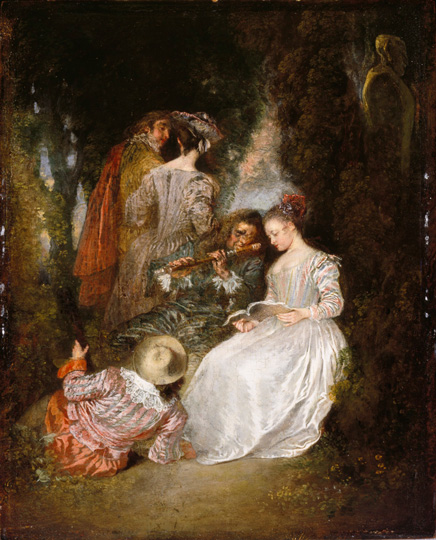
Los Angeles, California, Los Angeles County Museum of Art, Gift of the Ahmanson Foundation, inv. AC1999.18.1.
Oil on chestnut panel
35.5 x 28 cm
ALTERNATIVE TITLES
Un Concert champêtre
Un Concert dans un jardin
Espagnols & espagnolette
Fête champêtre
Garden Party
L’Intérieur dans un parc
Perfect Accord
Perfect Harmony
Perfetto accordo
RELATED PRINTS
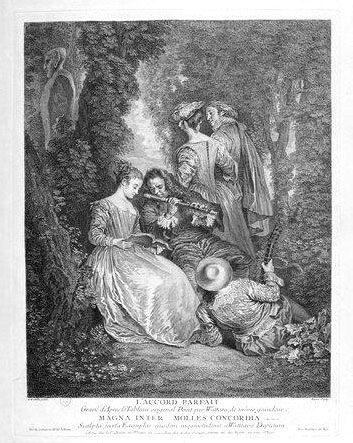
Bernard Baron engraved Watteau’s composition in reverse for the Jullienne Oeuvre gravé. The print was announced for sale in the June 1730 issue of the Mercure de France (p. 1184).
PROVENANCE
Paris, collection of Nicolas de Henin (1691-172; conseiller du Roi au Châtelet de Paris, intendant et ordonnateur des bâtiments du Roi). According to Mariette’s "Notes manuscrites," this painting and its pendant, La Surprise, were owned by Nicolas Henin. Indeed, they were listed in the inventory composed on February 4, 1724, after the death of Henin’s wife, Angélique Boucot: “deux autres petits tableaux peints sur bois représentant des Espagnols & Espagnolette, dans leur bordure de bois doré, originaux de Watteau, prisé deux cens livres.” Henin survived his wife by only four months, dying on June 16, 1724.
Paris, collection of Jean de Jullienne (1686-1766; director of a tapestry factory). Julienne apparently bought this painting and its pendant, La Surprise, after the death of Nicolas Henin. Baron’s engraving, executed just before June 1730, states: “Tiré du Cabinet de Mr de Jullienne.” Jullienne sold L’Accord parfait and its pendant before the compiling of the 1756 illustrated catalogue of his collection, a manuscript now in the Morgan Library & Museum, New York.
Paris, collection of Germain Louis de Chauvelin (1685-1762; marquis de Grosbois, garde des sceaux, Secretary of State for Foreign Affairs under Louis XV). His sale, Paris, June 21ff, 1762, lot 27: “Deux agréables Tableaux, peints sur bois, par Antoine Watteau; ils portent chacun 12 pouces de haut, sur 9 pouces de large. On les trouve gravés sous les titres de La Lorgneuse & de l’Accord parfait, le premier par Scotin, le second par Baron.“ According to an annotated copy of the catalogue in the Rijksbureau voor Kunsthistorische Documentatie, the pair of paintings sold together for 304.19 livres. Apparently at some point between 1730 and 1762 L’Accord parfait had been shorn of its original pendant of La Surprise and was paired instead with La Lorgneuse. The latter had originally been paired with Le Lorgneur. One wonders if this change was due to Jullienne or Chauvelin.Paris, collection of Jean-Baptiste August II Le Rebours de Saint-Mard (1746-1793; président de la troisième Chambre des enquêtes). His sale, Paris, April 27ff, 1778, lot 31: “Antoine Watteau. Cinq figures de caractere, dont une femme qui tient un livre de musique, & un homme qui joue de la flûte traversiere dans un jardin. Ce tableau agréable & dont la touche est facile, spirituelle & le coloris excellent, est peint sur bois; il porte 13 pouces de haut, sur 10 pouces de large.” Sold for 930.1 livres to “LeBrun Cadet” according to an annotated copy of the catalogue in the Rijksbureau voor Kunsthistorische Documentatie. The following lot (lot 32) was its faux pendant, La Lorgneuse.
Paris, collection of Jean-Baptiste Pierre Lebrun (1748-1813, painter and art dealer). His sale, Paris, December 10-16, 1778, lot 109: “ANTOINE WATTEAU . . . Un Concert dans un jardin. Sur le devant est une jeune femme tenant un livre de musique: un jeune homme l’accompagne en jouant de la flûte: à ses pieds est un scapin vu par le dos. Plus loin sur le second plan est un autre personnage tenant une jeune fille par le bras. Ce tableau qui est du meilleur tems de Watteau, doit être regardé comme un des chefs-d’œuvres de ce Peintre. Hauteur 13 pouces, largeur 10 pouces. T.“ According to an annotated copy of the catalogue in the Rijksbureau voor Kunsthistorische Documentatie, the painting sold for 1,300 livres. The collection was presented anonymously, but a copy of the catalogue in the Bibliothèque nationale de France has a penned notation on the title page: “app. à Lebrun.” The following lot was La Lorgneuse, although again it was not specifically designated as a pendant.
London, collection of Thomas Baring, Bart. (1772-1848). His sale, London, Christie’s, June 2-3, 1848, lot 84: “WATTEAU. A CONCERT CHAMPÊTRE, a lady holding a music book for gentleman who is playing the flute, a young man lying at her feet; and two other figures in the background.” The picture sold for £152.5 to White, probably a dealer, according to an annotated copy of the catalogue in the Rijksbureau voor Kunsthistorische Documentatie. The following lot, described as "the companion," was La Lorgneuse, but it was listed under the title of "A Masquerade Champêtre." The Rijksbureau’s copy of the catalogue is annotated “48 [for 84] & 85 Both Small landscapes.”
London, collection of Andrew James (1793-c. 1857; London corn merchant); by descent to his widow Ann (b. 1788). While in her possession, the painting was seen by Waagen who described it and La Lorgneuse as “Two small but attractive pictures, with gentlemen and ladies in the open air. In one of them is a very pretty girl seen in profile, and a couple turning from the spectator.”
London, collection of Sarah Anne James (1829-c. 1891; daughter of Andrew and Ann James). Her sale and others, London, Christie’s, June 20, 1891, lot 33: “A. WATTEAU . . . L’ACCORD PARFAIT: a lady and gentleman seated under a tree near a statue, he is playing the flute from a music-book which lies open on her lap, at their feet is seated another gentleman, with his back to the spectator, behind them another lady and gentleman are walking away/ Panel, 14 in. by 11 in. / And the engraving by Baron / Exhibited at Burlington House, 1891.” Bought for £3,675 by Samson Wertheimer according to the annotated copy in the Rijksbureau voor Kunsthistorische Documentatie.
London, collection of Samson Wertheimer, (c. 1811-1892; art dealer). His sale, London, Christie’s, March 19, 1892, lot 708: “A. WATTEAU . . . L’ACCORD PARFAIT: a lady and gentleman seated under a tree near a statue, he is playing the flute from a music-book, which lies open on her lap; at their feet is seated another gentleman, with his back to the spectator; behind them another lady and gentleman are walking away / 14 in. by 11 in.; and the engraving by Baron / Exhibited at Burlington House, 1891 / From Miss James’s Collection.” It was bought by the London dealer Thomas Agnew & Sons for £3,500 according to an annotated copy in the Bibliothèque nationale. An annotated copy of the catalogue in the Metropolitan Museum, New York, lists the price at £2,205. The latter figure may prove more accurate. Almost immediately after the sale, Boucaud noted that the price of the painting had dropped dramatically. According to him, Wertheimer had bought the painting for 92,000 francs and then, just a few months later, he sold it for merely 52,500 francs.
Hampstead (London), Kenwood House, collection of Edward Guinness, 1st Earl of Iveagh (1847-1927, brewer). The painting was bought from Agnew in 1892 and presumably remained with the family at Kenwood until it was sold in 1998. Yet a letter of March 1, 1983, from the Earl of Iveagh to John Jacob at the Iveagh Bequest, Kenwood, states that he did not know where the painting was. The picture was sold to the Los Angeles County Museum of Art via the London-based dealer Simon Dickinson in 1998 for approximately £4,000,000.
EXHIBITIONS
London, Royal Academy, Old Masters (1871), cat. 130 (as by Watteau, A Fête Champêtre, lent by Miss James).
London, Royal Academy, Old Masters (1891), cat. 55 (as by Watteau, Garden Party, lent by “the late Miss James”).
London, Sassoon House, Three French Reigns (1933), cat. 98 (as by Watteau, Pastoral Scene, lent by the Earl of Iveagh).
London, Royal Academy, European Masters of the Eighteenth Century (1954-55), cat. 237 (as by Watteau, Perfect Harmony [L’Accord Parfait], lent by the Earl of Iveagh).
London, Kenwood House, The French Taste in English Painting (1968), cat. 12 (as by Watteau, LAccord parfait, annonymous lender).
Valenciennes, Watteau et la fête galante (2004), cat. 56 (as by Watteau, L’Accord parfait, lent by the Los Angeles County Museum of Art).
SELECT BIBLIOGRAPHY
Waagen, Treasures of Art in Great Britain (1854-57), 3: 214.
Hédouin, “Watteau” (1845), cat. 63.
Hédouin, Mosaïque (1856), cat. 64.
Goncourt, Catalogue raisonné (1875), cat. 97.
Hannover, Watteau (1888), 99.
Bourcaud, Dessins, gouaches, estampes (1893), 532.
Zimmermann, Watteau (1912), 186 (under cat. 23).
Dacier, Vuaflart, and Hérold, Jean de Jullienne et les graveurs (1921-29), 1: 98, 3: cat. 23.
Réau, “Watteau” (1928), cat. 118.
Adhémar, Watteau (1950), cat. 120.
Davies, French School (1957), 223 (under cat. 2962).
Mathey, Watteau, peintures réapparues (1959), 69.
Mirimonde, “Sujets musicaux chez Watteau” (1961), 270.
Macchia and Montagni, L’opera completa di Watteau (1968), cat. 196.
Nicolson, “X-rays at Agnew’s” (1969), 165-66, 171.
Ferré, Watteau (1972), 3: 964-65, cat. B29.
National Gallery, Illustrated General Catalogue (1973), 800.
Roland Michel, Watteau (1981), cat. 239.
Roland Michel, Watteau (1984), 55, 266, 287.
Baker and Henry, Complete Illustrated Catalogue (1995).
Rosenberg and Prat, Watteau, catalogue raisonné des dessins (1996), 2: cat. 538, 576; 3: cat. R835.
Marandel, “Quelques notes” (2001), 284-87.
Temperini, Watteau (2002), cat. 106.
Los Angeles, Los Angeles County Museum (2003), 108.
Marandel, European Art (2006), 63-64.
London, Royal Academy, Watteau, the Drawings (2011), under cat. 75.
Glorieux, Watteau (2011), 162.
Vogtherr, Watteau at the Wallace Collection (2011), 117.
Wine, Eighteenth Century French Paintings (2018), 566-69.
RELATED DRAWINGS
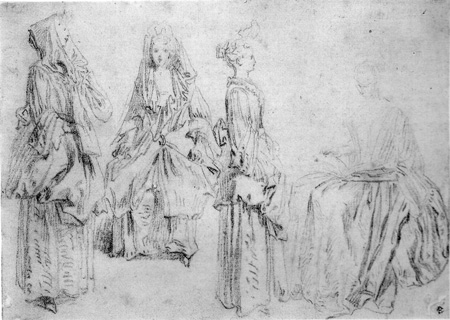
Although not previously recognized as such, the study of the seated woman looking at a partbook at the far right of a sheet in the Indianapolis Museum of Art (Rosenberg and Prat 68) may have been used for the woman in Watteau's first composition painted under L’Accord parfait.
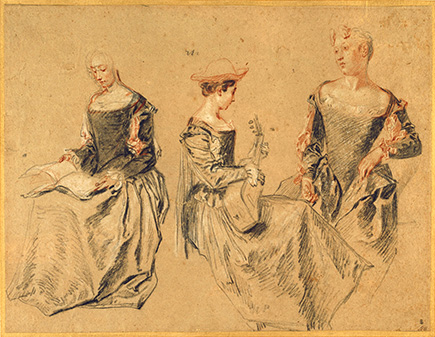
A sheet in the Chicago Art Institute (Rosenberg and Prat 538) has often been cited in relation to L’Accord parfait, and there are indeed correspondences in the general positioning of the body and the costume. But there also are considerable differences, especially in the positions of the head and the song book. Perhaps Watteau drew additional studies of this same woman on another sheet, one of which may have corresponded more closely to the figure in the painting.
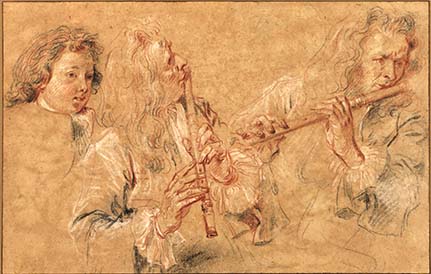
The flutist, evidently a portrait of an actual musician, was recorded twice by Watteau on a sheet now in the Getty Museum (Rosenberg and Prat 576). He used the study at the right, a forceful rendering of the flutist with an intent expression and furrowed brows.
REMARKS
Until 1969, there had been much confusion about the provenance and authenticity of L’Accord parfait. Most scholars presumed that the original work had passed to England and was the one sold from Miss James’s collection. It only remained, or so it seemed, to determine which extant version was the one that had been in the James collection. Some favored the picture in the Edmond de Rothschild collection, while others favored the one in the Duke of Sutherland’s collection. Zimmerman, followed by Dacier, Vuaflart, and Hérold, as well as by Réau, believed in the Rothschild painting. As it turns out, both the Rothschild and Sutherland pictures are just copies (see copies 2 and 4 below).
The original version had been with the Iveagh family since its initial purchase in 1892 and was publicly exhibited in 1891, 1933, and 1954. Adhémar and Davies recognized that it was the original version, yet when the painting was sold in 1998, it was greeted with fanfare as though it had long been hidden away. This is curious since, after all, it had previously been exhibited publicly and x-rays of the pentimenti were published in 1969. Once purchased by the Los Angeles County Museum of Art, this version received resounding support. The quality of execution and the visible pentimenti—particularly in the face of the flutist—reassured critics that this was the original version.
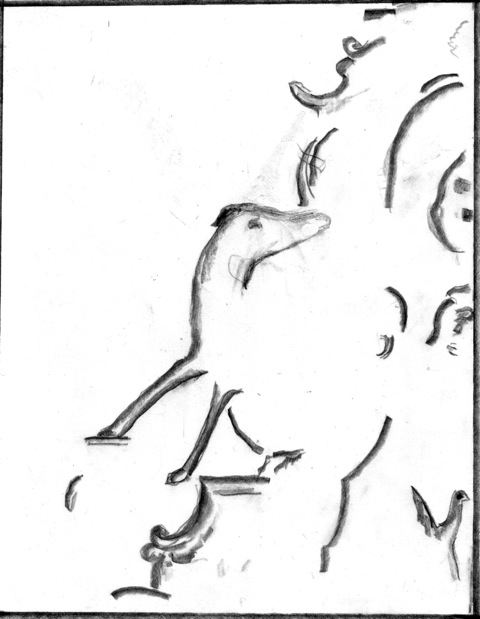
Diagram of the principal lines of the Claude Audran decorative design revealed by x-ray beneath L’Accord parfait.
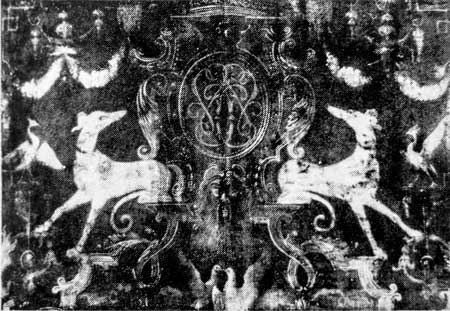
A reconstruction of the decorative designs by Claude Audran beneath L’Accord parfait and La Sérénade italien.
The x-rays of 1969 were an important corroboration of the authenticity of the Los Angeles painting. Under the topmost surface are two prior, superimposed compostions. The bottom layer, upside down in relation to L'Accord parfait, is the right half of a decorative symmetrical design. It shows a heraldic arrangement including the front portion of a dog with its front legs outstretched, half of an escutcheon, and a dove in the right corner. The other half of this symmetrical design lies under the surface of La Sérénade italienne, now in the Nationalmuseum of Stockholm. As shown in a reconstruction drawing made by the Nationalmuseum, the mirrored halves with the dogs, flying birds, and ribbons form a pleasant arrangement. The whole of the original panel was apparently destined for use as a carriage door. Nordenfalk theorized that the conjoined letters “V” and “C” in the shield, each employed twice, could have represented the October 1709 marriage of the marquis de Vaubourg and Mlle. de Vieuville, but there is no conclusive armorial proof. There is general agreement that the commission went to Claude Audran, since the design accords with his manner, and that would explain how Watteau, his assistant, came into possession of the panel. (It might be noted that a member of the Vieuville family owned Watteau’s Les Agréments de l’été in the late eighteenth century.)
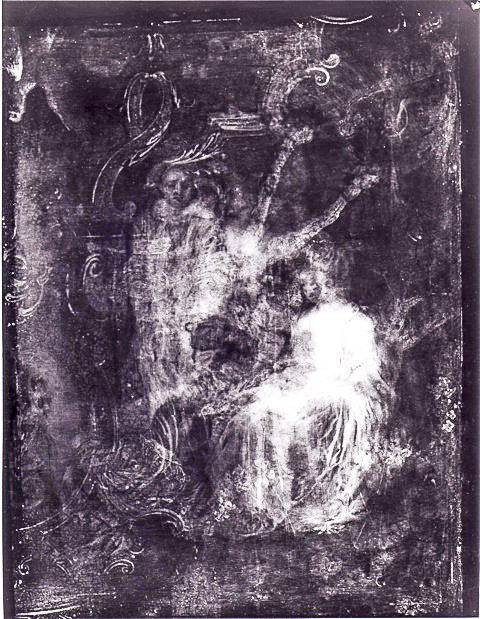
X-ray of the two levels of paintings beneath L’Accord parfait.
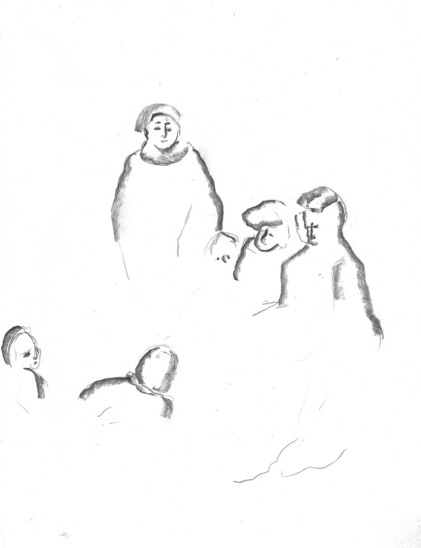
Diagram of the principal lines of the original Watteau composition revealed by x-ray beneath L’Accord parfait.

Present state of L’Accord parfait.
The 1969 x-rays also revealed an intermediate level. Painted over the decorative design but under the surface of L’Accord parfait can be seen an earlier figurative painting by Watteau. While it is clearly related to the final composition, there are several important differences. The seated woman at the center is similar to the character we see today, but her head was more upright and thus her posture was stiffer. Her male companion looks more to the left and seems not to have been a flutist. The couple walking away from the scene were apparently not included and, instead, a Pierrot stands in the background, looking at us full face; awkwardly stiff, his arms hang at his sides. At the lower left is a woman who does not appear in the final painting. Whereas L’Accord parfait has all the charm and grace of Watteau’s maturity, the preliminary composition is less pleasing. Earlier in both conception and style, it corresponds to early Watteau paintings such as Harlequin jaloux and the centers of some of his arabesques. When it was executed, it was intended as a pendant to another painting which now lies under the surface of the Stockholm panel.
It is generally agreed that L’Accord parfait is a work from Watteau’s maturity. The problem, however, is assigning it a specific date. Adhémar proposed 1716, the year to which she assigned an impossibly large portion of Watteau’s oeuvre (more than fifty paintings!). Rosenberg and Prat dated the drawings to c. 1717, which—if accepted—would establish a terminus post quem for the picture. Mathey opted for 1718-19. When the painting was shown in Valenciennes, Eidelberg suggested a date of c. 1717-18. Roland Michel, as well as Rosenberg and Prat, dated the painting to 1719. Marandel proposed that it was the last picture executed before Watteau’s trip to London in 1719. Grasselli favored 1719-1720, while he was in England, but it seems unlikely that the artist would have burdened himself with a previously painted but by then somewhat démodé panel when he crossed the Channel. Dacier, Vuaflart, and Hérold had sought to identify the standing man in the painting as a portrait of Dr. Mead, a not fully convincing theory. Vogtherr has opined that L'Accord parfait was painted in England, primarily because it was engraved by Baron who also engraved L'Amour paisible and the Comédiens italiens, both of which were owned by Richard Mead, and possibly Les Deux cousines. But a word of caution must be introduced because, after all, L'Accord parfait was owned by Henin, who presumably got the painting directly from Watteau in Paris. Moreover, Baron returned temporarily to Paris before 1730, i.e., before he engraved L'Accord parfait. Vogtherr, following the technical analysis of the painting discussed by Marie-Catherine Sahut, Élisabeth Martin, and Claudia Sindaco-Domas, posits that Les Deux cousines, another picture engraved by Baron, was painted by Watteau while he was in England, particularly because of unusual features such as the tinting of the white priming pigment with iron oxides. In short, although the evidence may favor the notion that L’Amour paisible was painted while Watteau was in London in 1719-20, it is not yet conclusive.
For copies of L'Accord parfait CLICK HERE